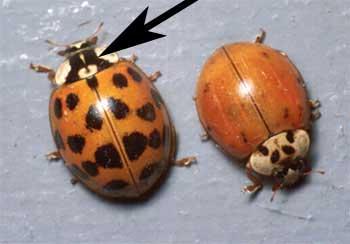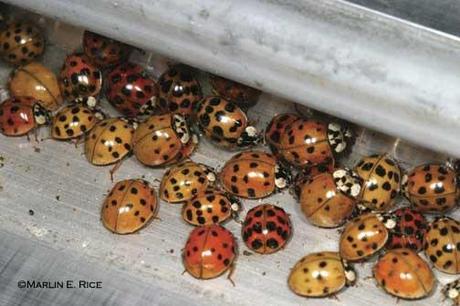We’re heading into winter—some of us in the US more than others–which means that you may soon find Asian lady beetles (commonly known as lady bugs) on your windows and in your light fixtures. Although they can be a nuisance, and can stink and stain surfaces if they’re crushed, they don’t do any harm. They’re just looking for a slightly protected space to hibernate.

Asian lady beetles. Photo courtesy of University of Minnesota Extension, http://www.extension.umn.edu/garden/insects/find/multicolored-asian-lady-beetles/
The Asian lady beetles are roughly a quarter-inch long, but their appearance varies. Their forewings may be yellow, orange, beige, or bright red. Ten black spots typically decorate each forewing, but it’s not uncommon for the beetles to have fewer spots, faded spots, or no spots at all. In the spring and summer, these lady beetles prey on aphids and scale insects, benefitting home horticultural and commercial agricultural crops alike. Cooling temperatures signal to adult lady beetles that it’s time to find a protected site where they can spend the winter.
There’s A Place
The lady beetles favor warm and sunny sides of buildings, as well as exposed, light-colored buildings, but any protected location offers some appeal. They may move indoors through cracks in weather stripping, or small gaps around window and door casings or through attic and soffit vents.
I’ll Be Back
You may have noticed that beetles frequently pick the same sites to overwinter. Research suggests that the beetles use chemical cues, possibly from beetle feces or attractant pheromones, to locate the particular crevice they want to inhabit, whether that’s in a tree or in your siding. Although they may seem to permanently inhabit, say, your overhead kitchen light fixture, they actually can’t survive for long periods within the centrally-heated rooms of your house. They prefer to shelter in wall voids or semi-insulated spaces. But they become more active on warm days and move towards bright surfaces, like light-colored walls or ceilings, or lighting fixtures or windowsills. That’s when you notice them.
It’s possible that large numbers of beetles may cause air quality problems indoors that could trigger allergies and/or asthmatic reactions. But fortunately for allergy sufferers, this lady beetle does not reproduce indoors. When the warmer temperatures of spring come around, they’ll move outside in search of food. And they don’t eat wood, so they won’t cause structural damage to your house or to your furniture.

Lady beetles clustered in doorframe. Photo courtesy of Iowa State University IPM. http://www.ipm.iastate.edu/ipm/icm/2007/3-26/asianladybeetle.html
If You’ve Got Trouble Here, There, and Everywhere, and Think It’s All Too Much, Remember All Things Must Pass. And I’m Here to Help.
What can you do to control the invasion?
You Can’t Do That
Don’t reach for the pesticides. You’ll waste your money. Pesticides are not very effective at halting beetle invasions. Spraying and fogging can be hazardous to your and your pets’ health, and excessive use may present fire hazards. Biological controls, like tachnid flies, offer limited effectiveness.
Blacklight traps can catch beetles well in some situations. USDA scientists in Georgia developed a trap that uses no insecticide and it catches the beetles alive for future release or disposal. The trap is about 12″ x 24″ and reportedly can be easily assembled or disassembled. Learn how you can build your own blacklight trap following the USDA’s instructions.
She Came In Through the Bathroom Window
The best approach is to exclude the beetles. Seal around windows, doors, siding, and fascia boards with caulk, weather stripping, or foam sealers. Snugly-fitting sweeps or thresholds on exterior doors can prevent beetles from crawling through those gaps. Keep your window screens in good condition and consider adding insect screens to attic and soffit vents. And as a bonus, doing those things will prevent cold air leaking into your house, saving you money on your heating bills and conserving energy.
Some people vacuum up the beetles. If you like this idea, try a tactic recommended by Dr. Susan Jones of The Ohio State University: Insert a knee-high nylon stocking into the vacuum’s extension hose and secure it with a rubber band. Then reattach the hose and vacuum up the insects. The beetles will be trapped inside the stocking. Remove the rubber band and secure it around the open end of the stocking, or simply tie a knot in the end. Take them outdoors to a protected space under a porch, deck, or shed, and let them hibernate there. In the spring, release them into your garden near aphid-infested plants. If the stocking approach is too much trouble, just use your regular vacuum bag, but be sure to remove it promptly and dispose of it outdoors.
For more information:
- Multicolored Asian Lady Beetle: OSU Extension Fact Sheet.
- Multicolored Asian Lady Beetle, Pennsylvania State University Extension Fact Sheet.
- Adapted from “Multicolored Asian Lady Beetles Inside Houses,” by Waldvogel et al., North Carolina Cooperative Extension Service. For more information, visit http://www.ces.ncsu.edu/depts/ent/notes/Other/goodpest/note107.html

